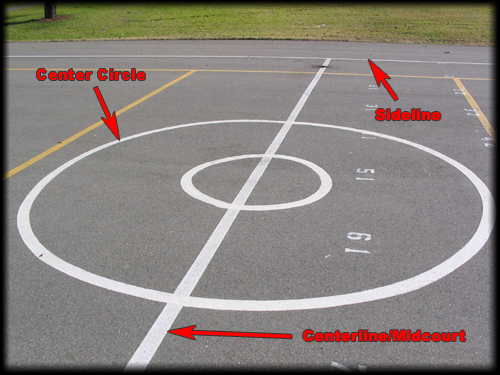History
The game of basketball was developed in 1891 by Dr. James Naismith, the physical education director at the YMCA College in Springfield Massachusetts. The first basketball games were played with a soccer-style ball and with peach baskets as the goals. Basketball was developed to help condition football and soccer players during the cold winter months. The First official game of basketball was not played until 1892. The first intercollegiate basketball game was played in 1896(Yale vs. Connecticut Wesleyan), and in 1899 women formulated their own rules. The National Basketball Association (NBA) and the National Collegiate Athletic Association (NCAA) govern the rules of basketball. Basketball is a very popular sport played at many YMCA’s, playgrounds, schools, colleges, community centers, and professionally.
Basic Game Organization
Basketball is played by 2 teams of 5 players: 2 guards, 2 forwards, and 1 center. The game begins with a jump ball at the center circle. Players attempt to outscore their opponents by passing and dribbling the basketball into position to then shoot it into their offensive basket. At the end of the game, the team with the most points wins.
Rule Violations
The following are violations of the rules and award the ball to the other team. The ball is put in play from the side line closest to where the violation occurred or the end line if the ball goes out at the end line.
1. Traveling- When the offensive player moves both of their feet while not dribbling the ball.
2. Double dribble- When the offensive player dribbles, stops, and dribbles again. It is also when you dribble the ball with both hands.
3. Out of bounds- When the player with the ball steps or dribbles on the boundary lines or completely out of the line.
4. Back court/Over and back- When the offensive team dribbles or passes into the back court once they have crossed mid court.
5. 5 seconds- This is when the offensive team does not inbound the ball within 5 seconds of possession.
6. 3 seconds in the lane- An offensive player may not remain in the lane area for more than 3 seconds
7. Carrying the ball- This is when the offensive player palms the basketball by carrying the ball over while dribbling. Another example is when the offensive player places their hand underneath the bottom half of the basketball while dribbling
Fouls
A foul is an infringement of a rule where free throws may or may not be given to the opponent. The rules on fouls are designed to prevent rough play in the game. The following are fouls:
1. Blocking- When an offensive player runs into a defensive player whose position has not been established. This is also when a defensive player runs into a moving offense player.
2. Charging- When an offensive player runs into a defensive player whose position has already been established.
3. Pushing/holding/tripping/grabbing- A defensive and offensive player may not push, hold, trip, or grab their opponent at any time.
Basic Terms
1. Offense- The team with the ball.
2. Defense- The team without the ball.
3. Jump ball- To start the game, the ball is tossed up in the center circle. A jump ball is also when two players from opposing teams are holding the ball at the same time.
4. Zone defense- This is when players protect a specific zone/area near the basket that their team is defending.
5. Man to man defense- Is when each player guards a player from the opposing team.
6. Rebound- A rebound is when an offensive or defensive player takes possession of the ball after a missed shot attempt.
7. Free throw- A one point shot taken from the free throw line which is awarded after a foul.
8. Field goal/basket- When the ball goes through the hoop. 2 points are awarded unless the ball has been shot from behind the 3 point line in which case the basket is given a 3 point value.
9. Lay up- This is a short shot where the offensive player uses the backboard to make the shot. This field goal is worth two points.
Types of Passes
1. Bounce pass- Two handed pass that and offensive player bounces to their teammate. This pass is meant to be thrown under the defensive players’ hands.
2. Chest pass- Two handed pass thrown from offensive player to offensive player that does not touch the ground.
3. Baseball pass- One handed pass that is meant to cover the majority of the basketball court.
4. Overhead pass- Two handed pass that an offensive player throws from over the top of their head. This pass is usually thrown with more power and covers more distance than the chest pass.
Court Dimensions
1. Basketball hoop 10 feet high
2. Free throw line is 15 feet from the basketball hoop.
Basketball Court Layout
1) center circle
2) lane/key
3) centerline/midcourt
4) basket(10 feet high)
5) sideline
6) endline
7) 3 point line
8) free throw line



